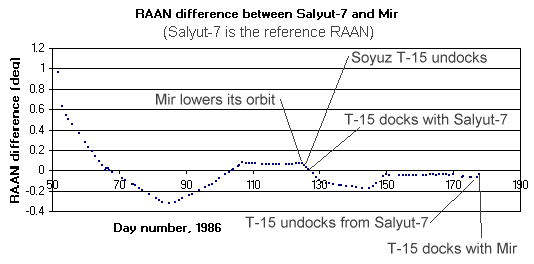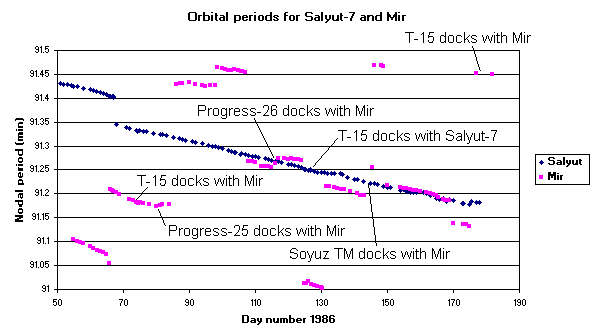
After the emergency medical evacuation of Salyut-7 in November 1985 there was unfinished business aboard that space station. However, there was political pressure to launch the new Mir space station (Mir was launched on 19 February 1986 at 2128:23 UT) and put cosmonauts on it promptly. To reconcile these two conflicting demands, Soviet space planners pulled off a really magnificent space operation: sending a crew first to Mir, then setting off for Salyut-7, staying there for 50 days and completing the military experiments with the TKS-M (a.k.a. Kosmos-1686) and then flying back to Mir.
All this was accomplished by injecting Mir into an orbit with its orbital plane very close to that of Salyut-7 and then using the propulsive capacity of Progress freight ships to maneuver Mir to drop off and pick up the Soyuz T-15 crew ship. Thus, Mir performed many maneuvers (see bottom figure) to control the planes and phasing of the orbits of the two stations. The Progress ships used were:
Here is the chronology
of the "fly-over"
| Soyuz T-15 Event | Date | Time | Remarks |
| Launched to Mir | 13 March 1986 | 1233:07 UT | |
| Undocked from Mir the first time | 5 May 1986 | 1212:09 UT | Day 125.508437 |
| Docked to Salyut-7 | 6 May 1986 | 1657:52 UT | Day 126.706852 |
| Undocked from Salyut-7 | 25 June 1986 | 1458:00 UT | Day 176.623611 |
| Re-docked to Mir | 26 June 1986 | 1946:07 UT | Day 177.823692 |
| Undocked from Mir | 16 July 1986 | 0909:50 UT |
During the time 23-29 May, the unmanned Soyuz-TM was also docked to Mir.
Before Mir maneuvered to approach Salyut-7 the distance to Salyut-7 was about 4100 km - and stationkeeping at a constant plane difference of 0.07 degrees (see figure below). Mir lowered its orbit to start approaching Salyut-7 from behind. This maneuver must have taken place on 4 May 1986 some time before 1610 UT (the epoch of the first element set in the lower orbit). At the time of undocking of Soyuz T-15 from Mir the distance had been reduced to about 2000 km. Actually, it seemed that Mir passed within about 25 km of Salyut-7 at about 2300 UT on 6 May 1986, about 6 hours after Soyuz T-15 had docked to Salyut-7. During the approach to Salyut-7 Soyuz T-15 moved away from Mir by only 125 km. In this way, the Soyuz did not have to make such extensive maneuvers. Mir worked as a "delivery truck" for the Soyuz craft - and as it turned out - as a "pick-up truck" when the crew returned. The lowering of the orbit also caused the orbital planes to be exactly co-planar at the time of docking (see figure below)

By comparing the plane difference figure above and the orbital period figure below it is easy to follow how the maneuvers of Mir changed the relative orientation of the orbital planes.
